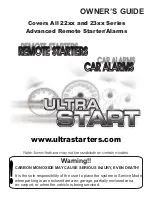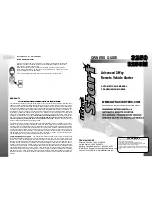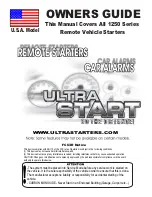
WARNING
CAUTION
WARNING
CAUTION
WARNING
CAUTION
Precautions during installation
Precautions during wiring
Precautions for moving or repairing the controller
Additional precautions
Do not install the controller where there is a risk of leaking flammable
gas. If flammable gas accumulates around the controller, it may ignite
and cause a fire or explosion.
Properly dispose of the packing materials. Plastic bags pose
suffocation hazard to children.
Take appropriate safety measures against earthquakes to prevent
the controller from causing injury.
To prevent injury, install the controller on a flat surface strong
enough to support its weight.
To reduce the risk of shorting, current leakage, electric shock,
malfunctions, smoke, or fire, do not install the controller in a place
exposed to water or in a condensing environment.
Controller must be installed by qualified personnel according to the
instructions detailed in the Installation Manual.
Improper installation may result in electric shock or fire.
When attaching the cover and the top casing to the bottom casing,
push it until it they click into place. If they are not properly locked
into place, they may fall, causing personal injury, controller
damage, or malfunctions.
To reduce the risk of damage to the controller, malfunctions, smoke, or
fire, do not connect the power cable to the signal terminal block.
Properly secure the cables in place and provide adequate slack in
the cables so as not to stress the terminals. Improperly connected
cables may break, overheat, and cause smoke or fire.
To reduce the risk of injury or electric shock, switch off the main
power before performing electrical work.
All electric work must be performed by a qualified electrician
according to the local regulations, standards, and the instructions
detailed in the Installation Manual. Capacity shortage to the power
supply circuit or improper installation may result in malfunction,
electric shock, smoke, or fire.
To reduce the risk of current leakage, overheating, smoke, or fire,
use properly rated cables with adequate current carrying capacity.
To reduce the risk of electric shock, shorting, or malfunctions, keep
wire pieces and sheath shavings out of the terminal block.
To reduce the risk of shorting, current leakage, electric shock, or
malfunctions, keep the cables out of contact with controller edges.
To reduce the risk of electric shock, malfunctions, or fire, seal the
gap between the cables and cable access holes with putty.
The controller should be repaired or moved only by qualified
personnel. Do not disassemble or modify the controller.
Improper installation or repair may cause injury, electric shock, or fire.
To reduce the risk of shorting, electric shock, fire, or malfunction,
do not touch the circuit board with tools or with your hands, and do
not allow dust to accumulate on the circuit board.
To avoid damage to the controller, use appropriate tools to install,
inspect, or repair the controller.
This controller is designed for exclusive use with the Lossnay by
Mitsubishi Electric. The use of this controller for other systems or for
other purposes may cause malfunctions.
Take appropriate measures against electrical noise interference
when installing the Lossnay in hospitals or facilities with radio
communication capabilities. Inverter, high-frequency medical,
or wireless communication equipment as well as power generators
may cause the Lossnay to malfunction. Lossnay may also
adversely affect the operation of these types of equipment by
creating electrical noise.
To avoid malfunctions, do not bundle power cables and signal
cables together, or place them in the same metallic conduit.
To prevent malfunctions, do not remove the protective film or the
circuit board from the casing.
To avoid damage to the controller, do not overtighten the screws.
Use a flat-head screwdriver with a blade width of 4-7 mm (5/32-9/
32 inch). The use of a screwdriver with a narrower or wider blade
tip may damage the controller casing.
To prevent damage to the controller casing, do not force the driver
to turn with its tip inserted in the slot.
To avoid discoloration, do not use benzene, thinner, ethanol,
hypochlorous acid or chemical rag to clean the controller. To clean the
controller, wipe with a soft cloth soaked in water with mild detergent, wipe
off the detergent with a wet cloth, and wipe off water with a dry cloth.
Eng-2
































